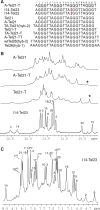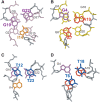Structure of a two-G-tetrad intramolecular G-quadruplex formed by a variant human telomeric sequence in K+ solution: insights into the interconversion of human telomeric G-quadruplex structures
- PMID: 19946019
- PMCID: PMC2817458
- DOI: 10.1093/nar/gkp1029
Structure of a two-G-tetrad intramolecular G-quadruplex formed by a variant human telomeric sequence in K+ solution: insights into the interconversion of human telomeric G-quadruplex structures
Abstract
Human telomeric DNA G-quadruplex has been considered as an attractive target for cancer therapeutic intervention. The telomeric sequence shows intrinsic structure polymorphism. Here we report a novel intramolecular G-quadruplex structure formed by a variant human telomeric sequence in K(+) solution. This sequence forms a basket-type intramolecular G-quadruplex with only two G-tetrads but multiple-layer capping structures formed by loop residues. While it is shown that this structure can only be detected in the specifically truncated telomeric sequences without any 5'-flanking residues, our results suggest that this two-G-tetrad conformation is likely to be an intermediate form of the interconversion of different telomeric G-quadruplex conformations.
Figures








Similar articles
-
Human telomeric sequence forms a hybrid-type intramolecular G-quadruplex structure with mixed parallel/antiparallel strands in potassium solution.Nucleic Acids Res. 2006 May 19;34(9):2723-35. doi: 10.1093/nar/gkl348. Print 2006. Nucleic Acids Res. 2006. PMID: 16714449 Free PMC article.
-
Structure of the Hybrid-2 type intramolecular human telomeric G-quadruplex in K+ solution: insights into structure polymorphism of the human telomeric sequence.Nucleic Acids Res. 2007;35(15):4927-40. doi: 10.1093/nar/gkm522. Epub 2007 Jul 10. Nucleic Acids Res. 2007. PMID: 17626043 Free PMC article.
-
Structure of the human telomere in K+ solution: a stable basket-type G-quadruplex with only two G-tetrad layers.J Am Chem Soc. 2009 Apr 1;131(12):4301-9. doi: 10.1021/ja807503g. J Am Chem Soc. 2009. PMID: 19271707 Free PMC article.
-
Polymorphism of human telomeric quadruplex structures.Biochimie. 2008 Aug;90(8):1172-83. doi: 10.1016/j.biochi.2008.02.026. Epub 2008 Mar 8. Biochimie. 2008. PMID: 18373984 Free PMC article. Review.
-
Molecular Recognition of the Hybrid-Type G-Quadruplexes in Human Telomeres.Molecules. 2019 Apr 22;24(8):1578. doi: 10.3390/molecules24081578. Molecules. 2019. PMID: 31013622 Free PMC article. Review.
Cited by
-
G-quadruplex formation in RNA aptamers selected for binding to HIV-1 capsid.Front Chem. 2024 Oct 22;12:1425515. doi: 10.3389/fchem.2024.1425515. eCollection 2024. Front Chem. 2024. PMID: 39502140 Free PMC article.
-
The major G-quadruplex formed in the human platelet-derived growth factor receptor β promoter adopts a novel broken-strand structure in K+ solution.J Am Chem Soc. 2012 Aug 15;134(32):13220-3. doi: 10.1021/ja305764d. Epub 2012 Aug 6. J Am Chem Soc. 2012. PMID: 22866911 Free PMC article.
-
Structural Switch from Hairpin to Duplex/Antiparallel G-Quadruplex at Single-Nucleotide Polymorphism (SNP) Site of Human Apolipoprotein E (APOE) Gene Coding Region.ACS Omega. 2018 Mar 31;3(3):3173-3182. doi: 10.1021/acsomega.7b01654. Epub 2018 Mar 15. ACS Omega. 2018. PMID: 30023863 Free PMC article.
-
Identification of G-quadruplex forming sequences in three manatee papillomaviruses.PLoS One. 2018 Apr 9;13(4):e0195625. doi: 10.1371/journal.pone.0195625. eCollection 2018. PLoS One. 2018. PMID: 29630682 Free PMC article.
-
Effect of sequence and metal ions on UVB-induced anti cyclobutane pyrimidine dimer formation in human telomeric DNA sequences.Nucleic Acids Res. 2014 Apr;42(8):5007-19. doi: 10.1093/nar/gku163. Epub 2014 Mar 4. Nucleic Acids Res. 2014. PMID: 24598261 Free PMC article.
References
-
- Blackburn EH. Telomere states and cell fates. Nature. 2000;408:53–56. - PubMed
-
- van Steensel B, Smogorzewska A, de Lange T. TRF2 protects human telomeres from end-to-end fusions. Cell. 1998;92:401–413. - PubMed
-
- Hackett JA, Feldser DM, Greider CW. Telomere dysfunction increases mutation rate and genomic instability. Cell. 2001;106:275–286. - PubMed
-
- Mergny JL, Helene C. G-quadruplex DNA: A target for drug design. Nat. Med. 1998;4:1366–1367. - PubMed
-
- Sun DY, Hurley LH. Targeting telomeres and telomerase. In: Chaires JB, Waring MJ, editors. Methods in Enzymology, Drug-Nucleic Acid Interactions. Vol. 340. San Diego: Academic Press Inc; 2001. pp. 573–592. - PubMed
Publication types
MeSH terms
Substances
Grants and funding
LinkOut - more resources
Full Text Sources
Medical

